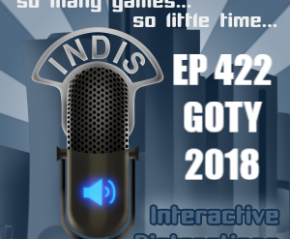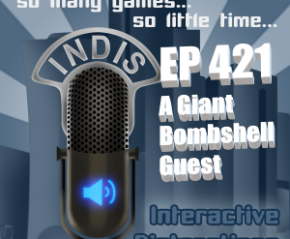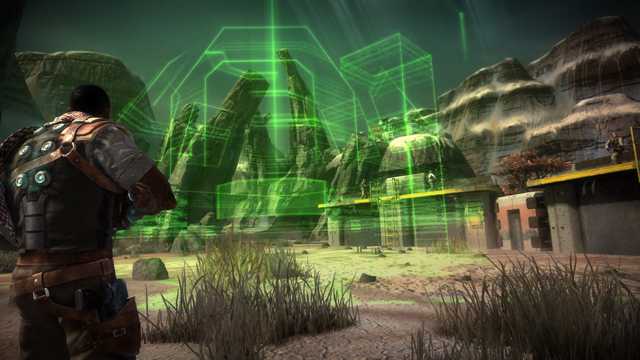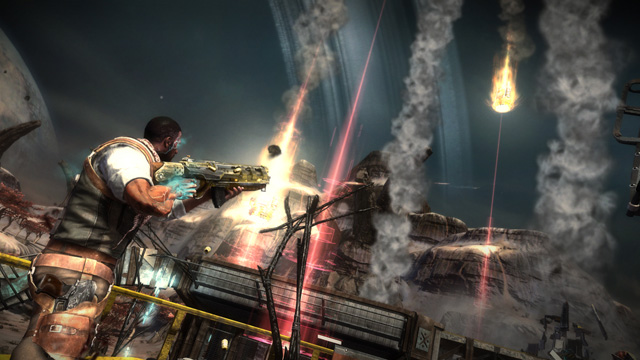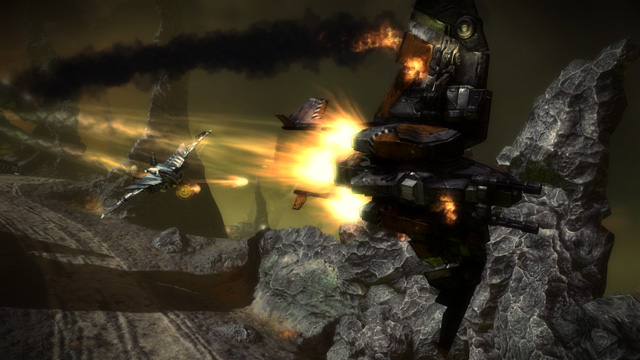Starhawk
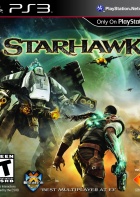

| Game Name: | Starhawk |
| Platforms: | PlayStation 3 |
| Publisher(s): | Sony Computer Entertainment |
| Developer(s): | LightBox Interactive, SCE Santa Monica Studio |
| Genre(s): | Third-person shooter, vehicular combat |
| Release Date: | May 8, 2012 |
| ESRB Rating: | T |
| Big Ups: | Amazingly frantic multiplayer action, interesting RTS-like building mechanics, good controls |
| Big Downs: | Lack of depth in story and characters, needs a team balance system in multiplayer |
So let me start off with this:
I was playing Twisted Metal back in the day; you know, maybe one to two years later when it was re-released to PlayStation’s Greatest Hits. Well, on the CD was a trailer for a game called Warhawk. Nowadays the game would look like trash, but for my ten year old mind in the middle of the 3D revolution the game looked like a fuck-awesome simulator. Sadly, that’s as far as I went with the series. Then when PlayStation 3 came out, another game called Warhawk came out the looked nothing like what I had seen in trailer of the PSX version. I was a little confused but chocked it up to an attempt at rekindling interest in a failed brand name. Again, that is as far as I went because I will still refusing to buy a PS3. Then I am sitting on my newly bought PS3 and Starhawk’s name keeps showing up, “Play the Starhawk Beta Now!” Well played advertising… you got me. So I played the beta for the evening and though it was pretty cool. Didn’t give it enough time to make a lasting memory, but it didn’t piss me off enough. So that when I saw its release drawing near and realizing that I could have a character that looks like Sweet Tooth (yep, I can be one of those guys at times) with the use of a code received from Twisted Metal, as you Atlanta folk say, I snatched that shit up.
And oh was I pleased that I did. Starhawk offers all of the great gameplay from PS3’s launch title Warhawk, but places it within a universe that appeals more to my interests: the distant future. Not only that, Starhawk has new features that incorporate basic RTS conventions into the fray. It is a very complex system reduced to very easy to use controls. However, this game is not for those who have no interest in multiplayer. The single-player is not only short but lackluster as well. It places the player in the shoes of Emmett Graves whose brother, Logan, was transformed into an Outcast during a joint effort to mine a futuristic oil surrogate known as the Rift. Trying to establish an emotional pull with the player with this and the typical love interest, the story feels more than slightly contrived. In its only ten levels, the story attempts to throw other twists and turns that build tension or emotion but is ultimately lost in its brevity. Regardless, I suggest you play through a majority of it since to get down the basic controls and gameplay elements you will need to understand for the online multiplayer.
Which is where the meat of the game lies. There is a coop mode that acts as a sort of horde/tower defense kind of like Sanctum, but the actual multiplayer quakes with so much intense nonstop action that it consumes the rest of the game. It does a fantastic job exemplifying the chaos and confusion associated with war. Starhawk’s unique gameplay shines here. As you run around in third-person as your puny soldier, you can “build” structures that drop in from the sky to manufacture vehicles or defend your base. Each building serves a unique purpose and allows for each player to utilize their strongest play styles. All of these structures are accessed through a single button press. This mechanic fosters an organic style of play by allowing players to use the Rift they gain from kills and other means to place buildings where they discover weak points. So as a match progresses, structures will endless be built, reclaimed, or destroyed so much that design of the end base will not even remotely resemble the beginning one.
The weapons hardly introduce anything original, containing the same old assault rifles, shotguns and rocket launchers, but with the building system, the game is guaranteed to always have that extra layer of depth that most third-person shooters don’t. Like any other multiplayer game, team balance is an issue. It is strange to me that more console games haven’t implemented an auto-balancing system like the ones that have been present on PC games for many years. Starhawk falls victim to this. A massive loss of players on one team can so drastically change the tide of battle so that winning is nearly impossible for the undermanned team. The multiplayer also has no penalty system for leaving mid-match which openly permits this abuse. When all is said and done though, the multiplayer still has its thrills. Respawning, which is renamed “Redeploying,” has the player dropping into combat in a pod. As soon as the pod impacts in the area the player selects, they can either opt to activate the deploy option or wait for the time to run out to erupt out of it with a screen-shaking explosion guns blazing.
The game’s namesake, the Starhawk, serves as the highest priority during a battle. Though foot and vehicle combat have their own relevance, Starhawks also offer diverse strategic options like allowing them to change into mechs to serve as land vehicles or become bombers with the correct weapon pickup. That makes them the Swiss army knife of vehicles. Not only that, they bring a feeling of constant combat throughout a match. The whirring sound as they plummet out of the sky or the blast from their thrusters as they accelerate in and out of combat reminds the player that the battle wages on. They also are need because if a team has no Starhawk pilots, the battle quickly will turn against them. For a multiplayer driven game, community is everything! Starhawk succeeds in creating one. It has the option to view gamelists as well as the ability to make or join clans. This ensures that players can easily be involved with a majority of the community population. Also, to quell the tedium of waiting for a match with a bunch of friends in a boring gameroom, the Multiplayer Homeworld allows players to meet up and goof off on a select map as they wait. Though minor, all together these features invigorate the monotony that poisons most multplayer games.
Starhawk lacks a major component however: character. It strives to be a sci-fi Western with its setting accented by dry guitar riffs and tribal beats but the Outcasts undercut this by their lack of development. Details about them are so scarce that it’s unclear what they represent. Normally I praise ambiguity but when it attributes to a lack of detail rather than functional and logical situations, I refuse to accept it. If only it had character; it would make the multiplayer than much more palpable if players could connect with either side in some way. However, this lack of character depth is made up by decent voice acting. Granted, the game takes itself a little too seriously, the characters still do not sound as cheesy as they appear. Aside from that, Starhawk presents itself wonderfully. For a tactical yet simple multiplayer, it is a blast. But if you are looking to be sucked into a uniquely fascinating universe, walk on.
